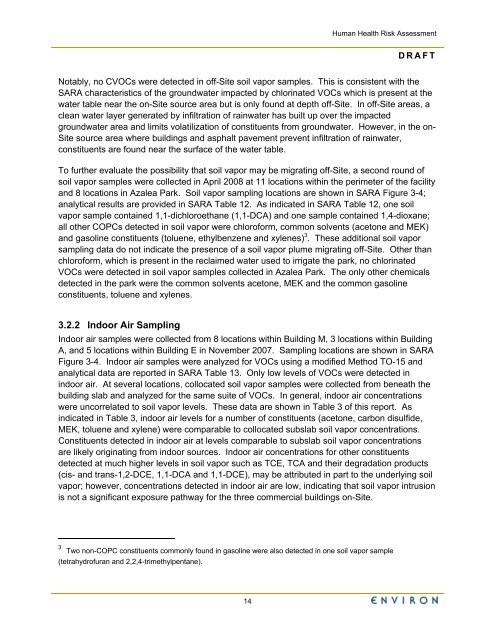Human Health Risk Assessment - Raytheon
Human Health Risk Assessment - Raytheon
Human Health Risk Assessment - Raytheon
You also want an ePaper? Increase the reach of your titles
YUMPU automatically turns print PDFs into web optimized ePapers that Google loves.
14<br />
<strong>Human</strong> <strong>Health</strong> <strong>Risk</strong> <strong>Assessment</strong><br />
DRAFT<br />
Notably, no CVOCs were detected in off-Site soil vapor samples. This is consistent with the<br />
SARA characteristics of the groundwater impacted by chlorinated VOCs which is present at the<br />
water table near the on-Site source area but is only found at depth off-Site. In off-Site areas, a<br />
clean water layer generated by infiltration of rainwater has built up over the impacted<br />
groundwater area and limits volatilization of constituents from groundwater. However, in the on-<br />
Site source area where buildings and asphalt pavement prevent infiltration of rainwater,<br />
constituents are found near the surface of the water table.<br />
To further evaluate the possibility that soil vapor may be migrating off-Site, a second round of<br />
soil vapor samples were collected in April 2008 at 11 locations within the perimeter of the facility<br />
and 8 locations in Azalea Park. Soil vapor sampling locations are shown in SARA Figure 3-4;<br />
analytical results are provided in SARA Table 12. As indicated in SARA Table 12, one soil<br />
vapor sample contained 1,1-dichloroethane (1,1-DCA) and one sample contained 1,4-dioxane;<br />
all other COPCs detected in soil vapor were chloroform, common solvents (acetone and MEK)<br />
and gasoline constituents (toluene, ethylbenzene and xylenes) 3 . These additional soil vapor<br />
sampling data do not indicate the presence of a soil vapor plume migrating off-Site. Other than<br />
chloroform, which is present in the reclaimed water used to irrigate the park, no chlorinated<br />
VOCs were detected in soil vapor samples collected in Azalea Park. The only other chemicals<br />
detected in the park were the common solvents acetone, MEK and the common gasoline<br />
constituents, toluene and xylenes.<br />
3.2.2 Indoor Air Sampling<br />
Indoor air samples were collected from 8 locations within Building M, 3 locations within Building<br />
A, and 5 locations within Building E in November 2007. Sampling locations are shown in SARA<br />
Figure 3-4. Indoor air samples were analyzed for VOCs using a modified Method TO-15 and<br />
analytical data are reported in SARA Table 13. Only low levels of VOCs were detected in<br />
indoor air. At several locations, collocated soil vapor samples were collected from beneath the<br />
building slab and analyzed for the same suite of VOCs. In general, indoor air concentrations<br />
were uncorrelated to soil vapor levels. These data are shown in Table 3 of this report. As<br />
indicated in Table 3, indoor air levels for a number of constituents (acetone, carbon disulfide,<br />
MEK, toluene and xylene) were comparable to collocated subslab soil vapor concentrations.<br />
Constituents detected in indoor air at levels comparable to subslab soil vapor concentrations<br />
are likely originating from indoor sources. Indoor air concentrations for other constituents<br />
detected at much higher levels in soil vapor such as TCE, TCA and their degradation products<br />
(cis- and trans-1,2-DCE, 1,1-DCA and 1,1-DCE), may be attributed in part to the underlying soil<br />
vapor; however, concentrations detected in indoor air are low, indicating that soil vapor intrusion<br />
is not a significant exposure pathway for the three commercial buildings on-Site.<br />
3 Two non-COPC constituents commonly found in gasoline were also detected in one soil vapor sample<br />
(tetrahydrofuran and 2,2,4-trimethylpentane).

















